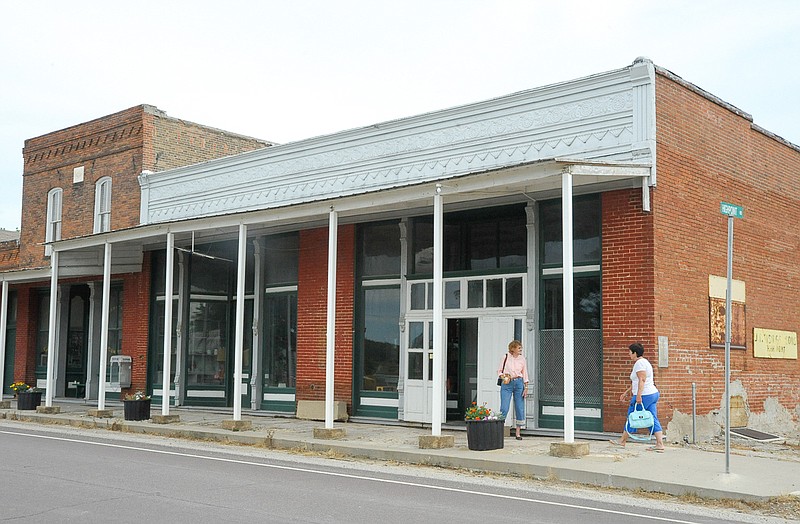HIGH POINT, Mo. - Through two robberies and one total fire, four generations of the Tising family have operated out of the High Point Business District.
The historic High Point central business block consists of four adjacent primary buildings and three detached privies behind them, which were listed on the National Register of Historic Places in 2004.
"Overall, the district strongly retains integrity from its 1874-1954 period of significance," the nomination said.
The location has been recognized as the third-oldest business in Moniteau County by the Moniteau County Historical Society, following from about 1845 with Henry Kelly then Thomas Hart and, finally, the Tising family.
The town's name was confirmed by the 1902 U.S. Geological Survey results, naming it as the highest point in Moniteau County. A marker says it is 904 feet above sea level.
H.H. Simpson is noted as the first settler of the High Point area in 1831. Many English immigrants soon followed. By 1835, 26 people lived in the community.
Mining, mostly lead and coal, was a draw for the area as early as 1841. The Simpson Coal Bank was discovered in 1857 and, at the time, was one of the largest deposits in the world. A narrow-gauge spur to the Rock Island Railroad line soon was laid.
Moniteau County was formed in February 1845 from parts of Cole and Morgan counties; and the Harrison Township, where High Point is located, was designated two weeks later.
Henry and Susan Kelly arrived in Mid-Missouri from Virginia by way of St. Louis to open a general mercantile in 1839. They moved to High Point and constructed the community's first store in September 1845. Kelly also established the post office, serving as both postmaster and shopkeeper until his death in 1852.
Thomas Jefferson Hart took over the mercantile business in 1855, expanding it to include wagons and grain drills. His tenure was marked with great success. Hart served in the Civil War with the Cole County Home Guards Company K as a first lieutenant. He later served as president of the Temperance Alliance and as a trustee of the local Odd Fellows. In 1880, he retired and became a successful flax farmer.
John Frederick Tising, the son of German immigrants, had opened a drug store in 1868 in a long-gone building behind the current store. Unlike his neighbor Hart, Tising served in the Union army. In 1874, Tising purchased the existing apothecary business in the corner building owned by Dr. James Dunlap.
Tising expanded into the mercantile storefront in 1880, partnering with R.S. Harvey to buy out Hart. The Tising-Harvey partnership was short-lived and after a dispute over a barrel of distilled water, Tising bought out his partner as the result of a coin toss.
The Tising corner building was a two-story brick built with Italianate influences in about 1874. It was a former meeting hall for the Independent Order of Odd Fellows Lodge (IOOF) No. 120. The Odd Fellows served the community in a variety of roles, one of the most important being the maintenance of the High Point Cemetery. Lodge No. 120 was organized in 1856 and it purchased the second story from Hart in 1860, using it as a meeting place until constructing its own meeting hall about 1880.
The Tising Mercantile was robbed and partially burned Sept. 26, 1892. The thieves used black powder to blow up the safe but to muffle the sound, they covered it with a blanket. The flames from the blanket then ignited combustibles in the store causing severe damage.
But the store was back in business within three weeks and the first floor rebuilt in less than three months. The wrecked safe became a flower planter for Mrs. Tising's front yard.
Each pilaster of the two recessed, double-leaf entrances are stamped with "Mesker Brothers, Front Builders, St. Louis, MO, Pat. Oct. 5, '87."
A second robbery occurred Aug. 2, 1926. The robbers took the charge books in addition to cash. The store might have failed if not for the honest response of residents to a newspaper ad requesting those with an outstanding balance come forward, the nomination said.
"Over the years, the Tising Store has housed a mercantile, apothecary, medical offices and was the original site of the High Point Post Office," the nomination said.
The store was a central point for the community, not only to buy and barter goods but also for socialization and the exchange of news.
"During the years spanning the Great Depression, the Tising Store remained in business by extending credit to its customers for a year, collecting only interest, then extending credit for another year. In doing so, the Tisings managed to survive the depression, and so did their customers," the nomination said.
Through the early part of the 21st century, the store was a field-trip destination for the local school. Much of the 19th century mercantile setting is still in place, including the sliding ladder to reach ceiling-high shelves, glass display cases, bulk item scale, a pot-bellied stove and original safes.
The next building west in the streetscape is the Post Office, which also was built in about 1874. It likely was a doctor's office before it was Bill Short's cafe. The U.S. Postal Service moved from Tising's store into the current location in the 1930s.
And the farthest west building in the historic commercial district is a two-story sandstone in the Craftsman style. The McGill Cafe was built in 1941 on the site of the original High Point Hotel by Lillie McGill as a multi-family residence, a grocery store and cafe.
Two traditional frame privies with shed roofs and a relatively elaborate brick privy with a gabled roof still stand behind the commercial buildings.

